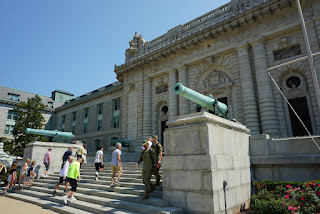September 16-17, 2023
We woke to cool weather this morning in North Carolina. That is our signal summer is over and it is time to go home. Unfortunately, we have been driving continually south for the last ten days and we now have a long drive back to Baltimore, MD. It is an easy drive on the interstate through North Carolina and southern Virginia. We pass the city of Halifax, NC where North Carolinians voted for Independence. To stretch our legs, we make a stop to visit the Chimborazo Medical Museum, another unit of Richmond National Battlefield Park. It is housed inside the old Confederate Hospital.
Medicine was very rudimentary during the Civil War. Training was meager, and bacteria were yet to be discovered. Three times more troops died from diseases like Cholera and Dysentery than gunfire. If you did receive a wound in battle, you would hope it wasn’t in the torso. They were usually mortal. A wound in the leg or arm required immediate amputation. With sanitation unknown, infection was almost guaranteed, but survival was good although very painful. The surgeon’s toolkit looked more like that of a carpenter. Your best hope was to die quickly on the battlefield.
For some strange reason the small hill where the hospital sits is named after the Chimborazo Volcano in Ecuador. This 20,000-foot mountain can claim to be the highest peak in the world because it lies on the equator where the earth bulges slightly.
After this quick visit, we were back on the road. The traffic near Washington DC was a nightmare despite it being Saturday. We clearly have too many people working for the Federal government. We almost got killed by a wild driver who careened from the right shoulder across our front hopscotching through traffic dangling part of his bumper. Maybe a stolen car. I surely don’t miss my work commute.
Hoping to let traffic die down, we made another stop in Fort Belvoir, VA, just south of DC, at the National Museum of the US Army. It is very large, and we don’t have time to do it justice. We watch the introductory film and then breeze through the many sections. One set covers the long history of American wars from Independence to the War on Terror. There are many interesting artifacts from a plywood Landing Craft from D-Day to one of General Grant’s early caps.
Another series of exhibit halls cover the many jobs and operations in the Army. Since the Air Force was initially part of the Army, they have also have a Wright Flyer on display. This is our third time this trip! They have a special art exhibit on Working Dogs. I think that was Aimee's favorite part.
Like its Marine counterpart, the museum is pretty good, but because the Army has such a long history and so many disparate functions it is by necessity very brief on some subjects and in other cases has to concentrate on a few chosen topics. We will have to come back.
We checked-in at our Baltimore airport hotel and then had dinner at a nearby seafood restaurant. Blue crabs weren’t on the menu. We settled for Clam Chowder and salad instead. Afterwards we returned the rental car.
Not wanting to drive anymore, we got up before dawn and caught two flights that quickly returned us to Arizona. Thank You Wilbur and Orville Wright. This was a successful cleanup tour of East Coast National Parks. We are now up to 390 out of 423. This list doesn't include 15 NPS affiliates and 24 National Monuments administered by other branches.
.jpg)
.jpg)
.jpg)
.jpg)













































